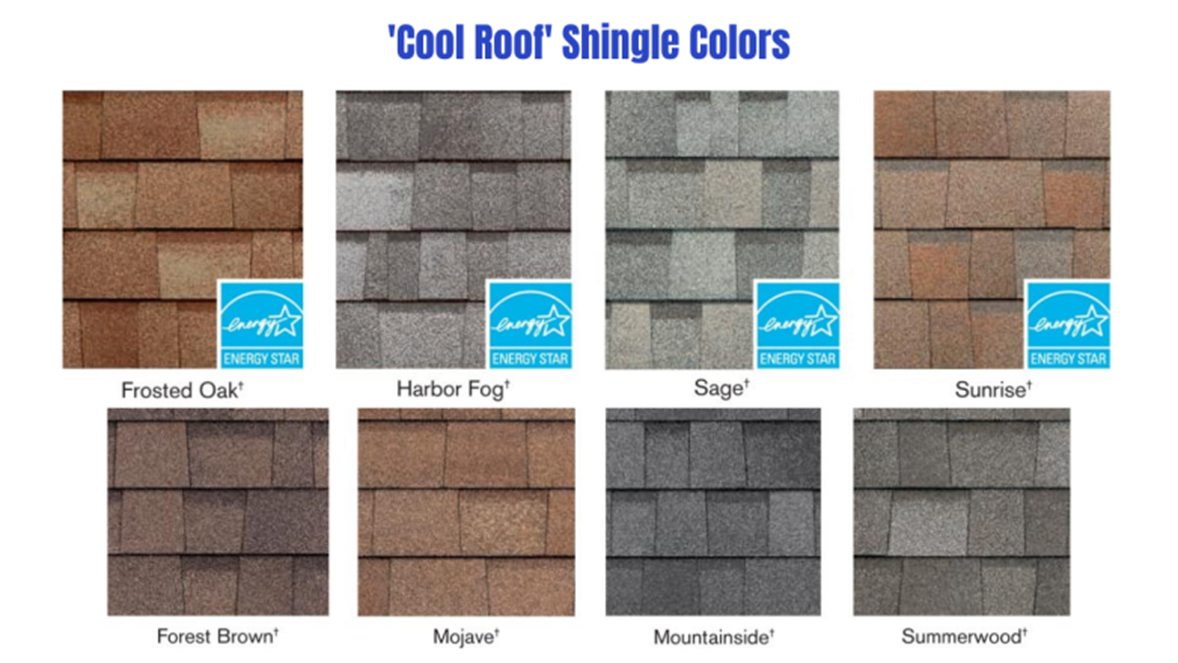
CoolRoofOwens: Samples of cool-roof shingles and colors; several companies manufacture similar tiles in a variety of colors. (Monica Kelly)
What You Need to Know about Cool Roofs
Cool roofs use light-reflecting roofing materials or coatings and are a simple and accessible means for individuals and communities to directly reduce carbon emissions, energy costs, and urban heat island effects. Project Drawdown, a global effort to draw down carbon emissions, estimates that cool roofs, along with green roofs (where roofs are covered with soil and vegetation for insulation), could reduce up to 1.1 gigatons of CO2 emitted globally by 2050. For more on cool roofs and other Drawdown solutions, see https://www.drawdown.org/. Below are answers to frequently asked questions about cool roofs.
How do cool roofs work?
Cool roof materials are similar to other roofing materials but are often lighter in color and reflect, rather than absorb, solar energy as compared to darker, traditional roofs. Less energy is needed to cool buildings with cool roofs and less thermal heat is released into the surrounding air. Using less energy for cooling helps mitigate greenhouse gas emissions. Cool roof materials vary and are rated on their solar reflectance and thermal emittance by the Cool Roof Rating Council (CRRC). The solar reflectance index (SRI) incorporates both measures. The higher the SRI rating, the cooler the roof will be in the sun, with ratings ranging from 0 to 100. The CRRC evaluations of roofing products and their reflective ratings are listed at https://coolroofs.org/product-rating/overview.
How much cooler are cool roofs?
According to Drawdown projections, with a traditional dark roof on a day with a temperature of 99 degrees, just 5 percent of solar energy is reflected back into space, with 95 percent heating the building and surrounding air. A cool roof, in contrast, reflects up to 80 percent, leaving the building and surrounding air cooler. Southern California Edison reports that cool roofs can reduce roof temperature by as much as 60 degrees during the summer. Similarly, the U.S. Department of Energy reports that under hot summer conditions a cool roof could stay more than 50 degrees cooler than a traditional roof.
Are there state regulations or local requirements regarding cool roofs?
Yes. California Title 24, Part 6, establishes building energy efficiency standards, which can be met by meeting an overall building energy efficiency performance standard or by specifically requiring a cool roof under a prescriptive approach, for new construction, additions, and roof replacements, with some exceptions. It gets complicated. Cool roof requirements vary by building type (residential, commercial, high-rise vs. low-rise), roof type (low or steep slope), and climate zone. California has sixteen climate zones, which allow tailoring to local conditions. All thirteen cities in the League of Women Voters Pasadena Area and part of Los Angeles are in climate zone 9, according to page 90 of the California Energy Commission’s 2019 Building Energy Efficiency Standards for Residential and Nonresidential Buildings.
There are no state cool roof requirements for low-rise residential buildings in climate zones 1–9 and 16. Changes to residential cool roof requirements are planned for the 2022 Energy Code revision of Title 24.
Local governments can establish cool roof requirements, as has been done in Los Angeles since 2015. The Los Angeles city building code requires residential roofing materials to meet a minimum SRI level for new construction and reroofing in residential and commercial buildings. Pasadena’s Building and Safety Division requires that cool roof materials be used for reroofing of nonresidential buildings, high-rise residential buildings, and hotels/motels, including roof replacements for more than 50 percent of the roof area or over 2,000 square feet of roof. There is no Pasadena cool roof requirement for reroofing of residential structures three stories or less.
Are cool roof materials available now, and do they look any different from the materials used for “hot” roofs?
Yes, cool roofing materials are available now. Shingles look like conventional roofing material available in tile, shake, shingle, and coating forms. They come in a wide range of colors, often in lighter shades than traditional roofing materials.
Are cool roofs more expensive than traditional roofs?
According to Cool California, cool roof costs are comparable to those of a standard roof of the same type, because coloration is responsible for a very small portion of the total installed cost of any roofing product. However, darker asphalt shingles may cost slightly more than light-colored cool roof materials. Because cool roofs last longer than traditional roofs, according to the CRRC, the period of extended use can reduce the lifetime cost of cool roof materials.
Additional costs may be offset by financial incentives for adopting cool roofs. Locally, the Los Angeles Department of Water and Power offers a rebate of between 20 and 30 cents per square foot of roofing meeting specific reflectivity values. Pasadena Water and Power offers a rebate of 20 to 25 cents per square foot for cool roofs. Southern California Edison offers a rebate of 20 cents per square foot of qualifying cool roof. To check for other rebates or incentives go to https://www.energyupgradeca.org/home-energy-efficiency/.
—Monica Kelly, Natural Resources Committee